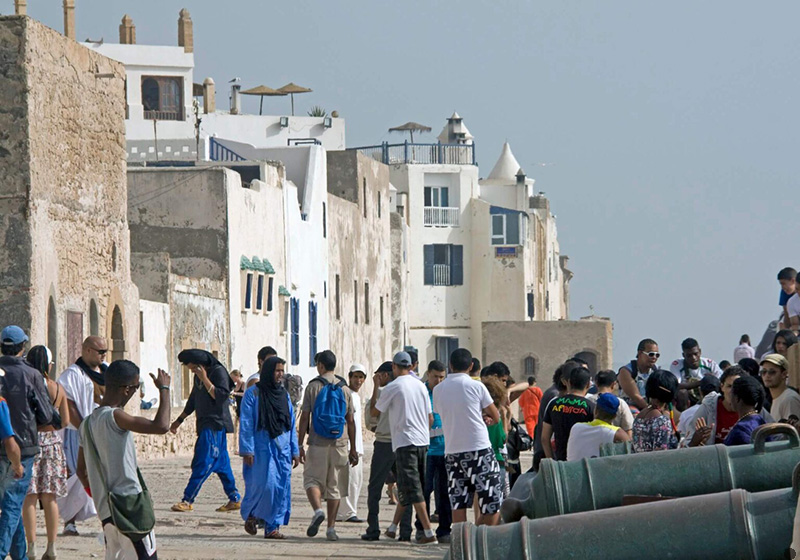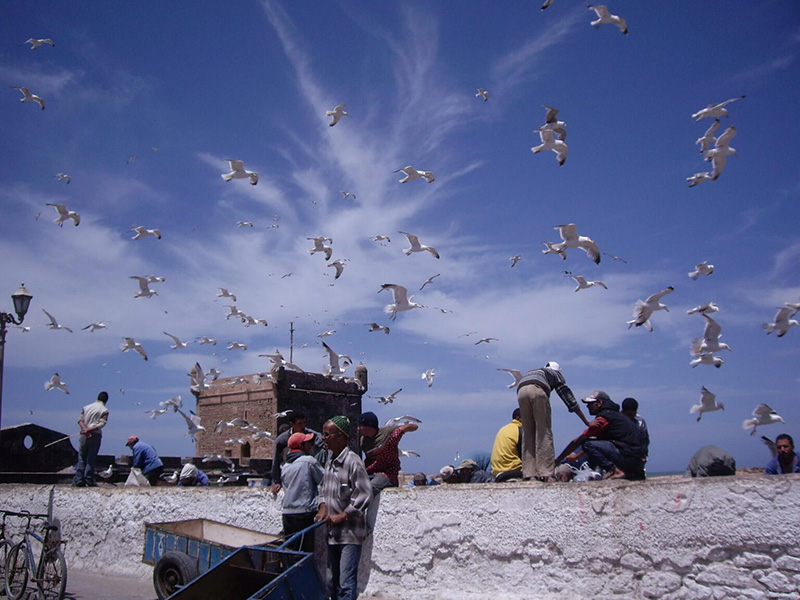The port of Essaouira is not as famous as the major ports of Morocco, such as the ports of Casablanca, Tangier, and Agadir, but this is exactly what attracts visitors to it. The simple wooden fishing boats spread on the Atlantic coast give the visitor a great sense of relief, calmness, and the ability to take a breath after getting tired, especially at sunset when the sun's rays cast their last lights on the ancient walls and watchtowers.
It's a small town with big secrets. It is enough to know that great cinematic and television works were filmed, such as Orson Welles' "Othello" in 1951, and the world's most famous "Game of Thrones" series.

Essaouira is not satisfied with being an artistic painting, but rather adds to this a beautiful semi-permanent habit of organizing art exhibitions and music festivals, including the Gnaoua Festival, which attracts music lovers from different regions of the world.
A rich history
The history of Essaouira dates back to before Christ, when the Phoenicians and Carthaginians were anchoring on the island of Mogador during their travel by sea to Ecuador. Essaouira, during the reign of the Tangier Mauritian King Yuba II, witnessed the establishment of the first factory for the manufacture of dyes extracted from oysters, which were exported to the Romans. During the sixteenth century, the Portuguese settled in it and called it Mogador, and at that time it was fortified by King Manuel I of Portugal, who built a fort there in 1506.

The actual establishment of the city can be considered to have started in the year 1765, when the Alaouite Sultan Muhammad III entrusted the task of rebuilding it in its current version to the engineer Theodore Comud, to become the city of Essaouira that we know now.
How to get to Essaouira
Essaouira has a small airport about 17 km from the city center, and it is possible to travel to it from outside Morocco by direct flight lines from European cities: Paris, Brussels, Toulouse, Bordeaux and Lyon. In general, the prices of flights to Essaouira are appropriate, especially since many low-cost companies provide direct flights to this windy city.
This does not preclude taking a different path, as it is possible to get off at Marrakesh or Agadir airport, coming from anywhere in the world, and then move towards the city, either by Grand Taxis or by bus towards Essaouira, on a trip that usually takes 3 hours. As for the transportation prices to Essaouira from Marrakesh, it is by bus in the range of 100 Moroccan dirhams (approximately $ 9), or in Grand Taxis, whose price is less than $ 9 per person.

Getting around 'Mogador'
To get to the city center you have to take a Petit taxi at around 150 dirhams ($14) for a ride that takes about 20 minutes. If you prefer public buses, there are buses that take visitors to the city from the airport at cheaper prices, throughout the day. For transportation within the city, there are public buses or Petit taxis, and their prices do not exceed 10 dirhams in total (one dollar).
City accommodation options
The city of Essaouira provides many options, from simple apartments provided by the owners at very reasonable prices, sometimes starting from 100 dirhams ($ 10), to guest houses, and hotels of various classifications of three, four, and five stars, according to the ability and budget of each tourist.
Most of these residences and hotels are located in the city center, and therefore transportation is hardly a problem in this extravagant city. Knowing that young people and students also have a place in Essaouira, where you can stay in the city's youth hostel, at low and appropriate prices.
Where to start to get to know more about Essaouira
Essaouira is a really small city, but it has a great history. So, it is okay to start your tour and get lost in the middle of the port fort, which is an old military barracks located in the heart of the port, and it is the landmark that was built during the eighteenth century as one of the main defensive fortifications to house soldiers and ammunition and receive water supplies in order to protect the port from possible marine attacks.

This tour will lead you to get acquainted with the neo-classical style of European military buildings, especially what distinguished King Manuel I of Portugal, which consists of two fortified wings of 200 meters that intersect at right angles, connected to the marina door overlooking the sea, where you will find blueness and seagulls that tell you the story of a rich history .
And after taking a deep breath of the sea air and the aromas of delicious grilled sardines, you can stop by the old city of Essaouira, or "Mogador" in its original name.
Due to its importance and value, the ancient city of Essaouira was included in the list of World Heritage Sites by UNESCO in 2001. Essaouira is a living example of the seventeenth century fortified cities in Morocco and North Africa according to the military engineering foundations of that era, and a model for the blending of European and Islamic engineering.

As for the Mellah or the Jewish neighborhood, it is a testament to the feature of coexistence that has been imprinting the Moroccan people and their ethnic and spiritual richness. You can enjoy a lot of your tour in this neighborhood, whose construction dates back to the Saadi Sultan Ahmed Al-Mansur Al-Dhahabi at the end of the 16th century AD, to whom he brought a group of Jewish merchants to revitalize the commercial port of Essaouira, so it was known historically as the Sultan’s merchants’ Mellah.
The tour may lead you to discover the Jewish cemetery (access is free), where exist the tomb of Haim Pinto VI, a 19th-century rabbi, and community leader still respected by the Essaouira Jews in the diaspora, then continue along the Mellah Street to find yourself facing the Haim Pinto small Synagogue, Famous for its blue-tiled prayer room.
At the end of the tour in the Mellah neighborhood, do not forget to visit the Museum of Memory House, which is a concrete example of the coexistence that characterized the city between its inhabitants, Muslims, and Jews.
Mogador Archipelago
From the fragrant history to the beauty and charm of nature, you can move to the Mogador Archipelago, via simple boats, which is a large rock that appears to you one kilometer from the historical harbor of the City of Winds, and it is composed of two main islands and 5 small islands.

These islands offer a beautiful, distinct and charming landscape that appeals to nature lovers and those interested in ancient history through its impregnable fortifications and ancient cannons, as well as scenes of migratory birds and seagulls that greet you during your coming and going. And if you want to rest from the fatigue of a busy day, it is sufficient to stop by Moulay El Hassan Square, in the center of the city, to communicate with the people of the city and watch life as it fills with bustle in the evenings of Essaouira, which does not leave you a chance to get bored.
City of culture and festivals
A state of beautiful disorientation will afflict you as you discover the permanent art exhibitions of Essaouira, from the luxurious "Le Real Mogador" palace, which includes paintings by contemporary Moroccan artists, to the "Kasbah Gallery", which is the largest and most eclectic, and which includes different art schools in which reality mixes with the surreal dream. In addition to many other museums and galleries spread in the city.

What about festivals?
It is the strong point of the city of Essaouira, as it organizes one of the largest festivals in Morocco, the Gnaoua World Music Festival, which lasts for 3 weeks, and carries with it different styles of music. The Gnaoua and World Music Festival is a festival organized in June of each year and presents unique musical performances that promote Gnaoua music and international and traditional music and enhance the richness of the world's musical heritage.
The tour is over.. the story is not over
The story of Essaouira is a long and timeless tale. It's hard to end up with a tour through the city, as what you don't see is always more than what you did. But you can finally, after tiring a long day, to sit on the walls of the old city to contemplate the sun of Essaouira as it sets, leaving behind many dreams of passers-by, at the sound of seagulls exchanging expressions of love, and the return of exhausted fishermen, over the sound of warm tea flavored with Moroccan mint, or even a traditional sardine dish.






